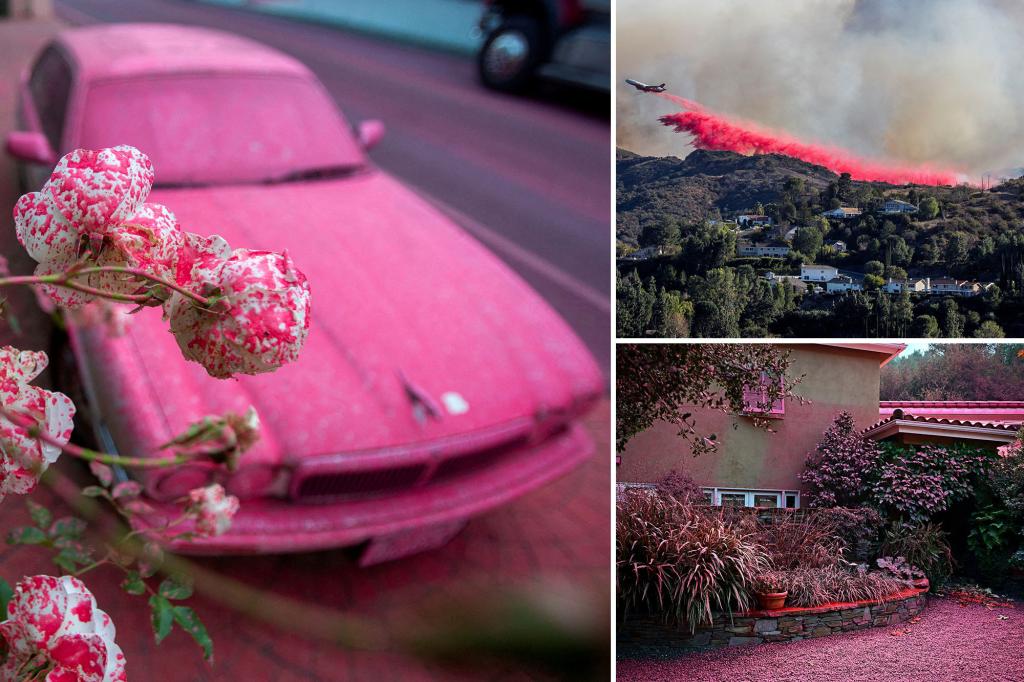The devastating wildfires raging across Southern California, notably the Eaton and Palisades Fires, have painted a grim landscape of destruction and displacement. As firefighters battled relentlessly against the infernos, utilizing innovative tactics such as dropping pink fire retardant from aircraft, a looming threat emerged in the form of the notorious Santa Ana winds. These powerful, dry winds, with gusts anticipated to reach up to 75 mph, posed a significant risk of re-igniting contained areas and sparking new blazes, further exacerbating an already dire situation. The communities affected faced a double-edged sword: battling the immediate flames while bracing for the potentially catastrophic impact of the returning winds. With over 200,000 people displaced from their homes and a tragically mounting death toll of at least 24, the urgency of the situation was undeniable.
The utilization of pink fire retardant represents a crucial tactic in wildfire suppression. This specialized chemical mixture, easily identifiable by its vibrant hue, is dropped from aircraft onto vegetation ahead of the fire’s path. The retardant acts as a barrier, slowing or halting the fire’s advance by creating a non-flammable layer. This strategy allows ground crews to establish more effective firebreaks and gain a critical advantage against the rapidly spreading flames. The visibility of the pink retardant also aids in coordinating firefighting efforts, allowing pilots to precisely target drop zones and ground crews to assess the effectiveness of the application. While the effectiveness of retardant can be influenced by factors such as wind speed and vegetation density, it remains a vital tool in the fight against wildfires, particularly in challenging terrain.
The Santa Ana winds, a recurring meteorological phenomenon in Southern California, are infamous for their role in fueling and intensifying wildfires. Originating in the high-desert regions, these dry, down-sloping winds compress and heat up as they descend towards the coast, creating extremely dry and volatile conditions. The high wind speeds further exacerbate the fire danger by rapidly spreading embers and creating swirling fire vortices, making containment efforts exceedingly difficult. The combination of dry vegetation, low humidity, and strong winds creates a perfect storm for rapid fire spread, posing a significant threat to both lives and property. Predicting the precise behavior of the Santa Ana winds adds another layer of complexity to wildfire management, emphasizing the need for proactive evacuation strategies and robust firefighting resources.
The impact of these wildfires extends far beyond the immediate devastation of scorched earth and lost homes. The displacement of hundreds of thousands of residents creates a humanitarian crisis, requiring extensive resources for shelter, food, and medical assistance. The emotional toll on individuals forced to flee their homes, often with little warning, is immeasurable. Beyond the immediate human impact, the wildfires also have far-reaching ecological consequences, disrupting ecosystems, harming wildlife, and contributing to air pollution. The long-term recovery process will require extensive rehabilitation efforts to restore both the natural environment and the affected communities.
The ongoing battle against the Southern California wildfires underscores the critical need for comprehensive wildfire management strategies. This includes proactive measures such as controlled burns to reduce fuel loads, creating defensible space around structures, and implementing early warning systems to facilitate timely evacuations. Investing in advanced firefighting equipment and technology, along with well-trained firefighting personnel, is crucial for effectively combating these increasingly frequent and intense wildfires. Public awareness campaigns play a vital role in educating communities about fire safety and encouraging preparedness measures.
In the face of these devastating wildfires, the resilience and collaboration within the affected communities are remarkable. Neighbors helping neighbors, volunteers providing support, and first responders working tirelessly demonstrate the strength of the human spirit in times of crisis. While the recovery process will undoubtedly be long and challenging, the collective efforts of individuals, organizations, and government agencies will be instrumental in rebuilding and restoring the affected areas. The ongoing struggle against the wildfires serves as a sobering reminder of the power of nature and the importance of proactive measures to mitigate the devastating impacts of these increasingly frequent events.

